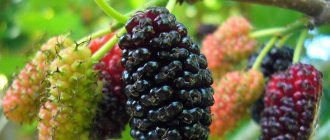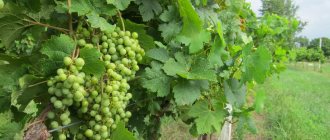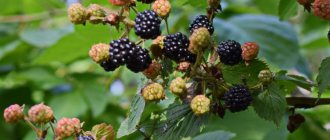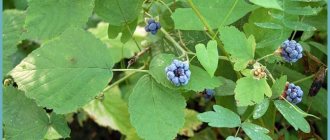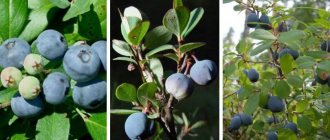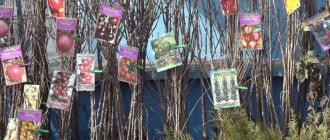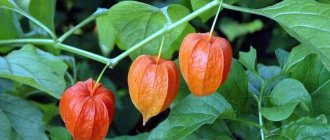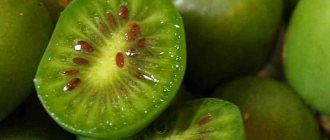The best varieties of cherries for the Urals
Few varieties of cherries can develop and bear fruit normally in such harsh conditions. These include the following:
- Ariadne.
- Bryanochka.
- Veda.
- Gronkova.
- Here we go.
- Large-fruited.
- Ovstuzhenka.
- Odrinka.
- Orlovskaya pink.
- Poetry.
- Revna.
- Tyutchevka.
- Fatezh
- Cheremashnaya.
Most of these varieties are a product of selection by the All-Russian Research Institute of Lupine, located in the Bryansk region. It was there that work was carried out to develop winter-hardy cherry varieties. The frost resistance of these varieties is about -30°C, which is not enough in the harsh Ural winter.
Planting and caring for cherries in the Urals
The procedure for planting cherries in the Ural region is no different from planting them, for example, in Crimea or the Krasnodar Territory. It is preferable to prepare planting holes in the fall. The location should be chosen on the sunny side of the site and sufficiently protected from the north wind. The soil taken out of the pit is mixed with humus. They will need to cover the roots of the cherry seedling when planting, adding another 0.2 kg of superphosphate.
A two-year-old cherry seedling is usually planted along with a lump of earth on the roots. If the roots are bare, they must be spread along the earthen mound, which must be poured onto the bottom of the hole. The seedling is installed vertically and covered with nutrient soil, periodically compacting the soil. If this is not done, voids may form inside the planting hole and the roots of the seedling will simply hang in the air.
The root neck of the seedling should be 3-5 cm above ground level. After planting, the plant should be shed generously with water and the soil should be mulched with humus.
Subsequent care of planted cherries includes the formation of the crown using pruning, as well as sanitary pruning, fertilizing and watering. Periodic spraying with various preparations is also carried out to prevent the occurrence of diseases and pests.
The nuances of growing cherries in the Urals
When growing cherries in the Urals, gardeners almost completely refuse to use nitrogen fertilizers so as not to stimulate excessive tree growth. The plant is formed small and compact.
To increase resistance to frost, grafting is often done on more winter-hardy cherries, and at a fairly high level, about 1–1.2 m. This protects the tree from sunburn. The grafting is done both on seedlings and on cherry shoots or in the crown.
Growing cherries in the southern Urals
The Southern Urals are undoubtedly a more favorable region for growing cherries. This applies primarily to the Orenburg region, the southernmost in the region. The predominant winds here are not cold Arctic ones, as in the Northern and Central Urals, but western ones, so winters here are milder and there is more precipitation.
Preparing cherries for winter in the Urals
To increase winter hardiness, cherries are grafted onto local frost-resistant cherry varieties, for example, Ashinskaya. Often grafting is done into the crown of an already mature tree. If the tree is grown from a seedling, it is formed into a bush to limit its growth to a height of 2 m. This will allow its branches to be bent to the ground in winter and covered with snow. They begin to bend down the branches at the end of summer.
To prepare a tree for winter, foliar feeding with potassium monophosphate is often carried out in August. In addition, defoliation is used - spraying with urea at the end of summer to accelerate the fall of leaves. Defoliants significantly increase winter hardiness.
If shoot growth has not stopped by August 1, it is necessary to stop it artificially. To do this, annual shoots are pinched. This will speed up the lignification process and improve frost resistance.
Reviews about cherries in the Urals
Recommended varieties for the Urals
When choosing among a wide variety of good and best varieties for planting in the Urals, you should give preference to specimens from the rating of the most popular species. Cultivating proven varieties will help you avoid common mistakes and get a good harvest.
Early ripening
Early ripening cherries begin to ripen in early to mid-June. Early crop varieties for the Urals include:
- Here we go. The variety is characterized by a spreading pyramidal crown and large inflorescences. The berries are medium-sized, dark red, heart-shaped.
- Leningradskaya black. A tall variety with small but juicy fruits. The shape of the berries is oblate-ovoid, the taste contains notes of honey.
- Mayskaya. Vigorous cherry, resistant to many infections and frost. The fruits are small, round, with dense and sweetish pulp.
Mid-season crops
The ripening period for mid-season varieties occurs in mid-summer. Among these varieties are common:
- Annushka. Vigorous trees with a spreading crown and fruits weighing up to 10 g. The berries have juicy pulp, a pronounced aroma and a sweet taste.
- Adeline. A productive variety that produces medium-sized trees. The fruits are bright red in color, weigh up to 6 g and have elastic flesh.
- Teremoshka. Self-sterile variety requiring pollination from other crops. Trees with a spherical crown are resistant to disease and bear fruit with a honey flavor.
Late varieties
Late-ripening varieties are grown in rare cases in the Urals due to harsh climatic conditions. When planting late varieties, complex care and protection from frost are required. The varieties of late cherries that are suitable for cultivation in the Urals include:
- Michurinskaya late. Fruits weighing 6-7 g ripen at the end of August. The berries have a round shape, deep red skin and juicy pulp with a sweet taste.
- Bryansk pink. Trees of this variety have a dense crown and medium-sized fruits with pinkish skin. The pulp of the berries is dense, yellowish in color. The crop tolerates long-term storage and transportation.
See also
How to propagate cherries using green cuttings and layering at homeRead
Winter-hardy tree varieties
The winter hardiness indicator is one of the important criteria for choosing a cherry variety. The most resistant varieties include:
- The first swallow. The heart-shaped berries weigh more than 5 g and can withstand sudden drops in temperature. The skin of the fruit is shiny, the skin is dense.
- Firstborn. A universal high-yielding variety of medium-late ripening. The fruits ripen in July and reach a weight of 7 g. The harvest has juicy pulp and a sweet taste.
Planting cherries in spring in the Urals
Taking into account the harsh climatic realities, planting cherry seedlings in spring in Siberia is the best option. It allows young fruit trees to gain strength during the spring-summer period and prepare for the first winter in new conditions.
How to plant cherries correctly? In Siberia in the spring, the threat of return frosts persists until the beginning of June, so the purchase of seedlings is usually planned for May. Seven tips on which cherries to plant in Siberia and how to choose seedlings with ACS:
- The roots should be well developed and free of growths and swellings.
- The bark on the trunk is smooth, without spots or scales. If it is wrinkled, then most likely the seedling is overdried and it is impossible to plant it in Siberia with minimal losses.
- The crown of the seedling should consist of 3-4 branches, each 30-40 cm long.
- Damage to the buds in the crown area is unacceptable, otherwise the further development and formation of cherries will be difficult.
- Young cherries adapt to new conditions faster than adults, so it is preferable to plant 1-2 year old seedlings.
- Cherries that are planted in the spring must have a trunk diameter of at least 1.5 cm.
- In order to be able to subsequently cover the cherries for the winter, at least in the first two years of life, it is preferable to plant a plant with a low trunk or grown in a creeping (stale) form.
Which cherries to plant in Siberia, or how to choose the right rootstock? The climate of Siberia is harsh for the traditionally southern crop, so winter-hardy rootstock is especially important for it. The best results of frost resistance are shown by cherries grafted onto cerapadus (an interspecific cherry-bird cherry hybrid) and onto seedlings of common cherries of Central Russian varieties (usually Vladimirskaya and Shubinka are used). VSL-2 is considered the best clonal rootstock for cultivating cherries in the stale form; it reduces the height of grafted varieties by 50%.
Siberian gardeners with grafting skills can plant local forms of wild cherries (seedlings or shoots) for rootstocks. Although there are disagreements regarding the advisability of using steppe cherry (Prunus fruticosa) as a rootstock. Well, purchasing cuttings of the required varieties for scions today is not a problem.
Landing place
The choice of place where to plant a cherry seedling in Siberia should be approached carefully, because... This will be half the success of growing cherries in Siberia.
- The site must be protected from cold air masses and drying winds. This could be a natural barrier - a hillside, a dense wall of trees in a nearby forest. Or artificially created - a stone wall of a building or a reliable high fence, a compacted hedge.
- In the area where it is planned to plant cherries, there should be no local depressions in the relief - holes, ditches, depressions, depressions in which water can accumulate during the spring melting of snow. Cherry does not tolerate the soaking of the root collar and the annular heating of the bark of the trunk; for it this is certain death. Low areas are dangerous due to the accumulation of cold air masses, which is especially destructive during the flowering period.
- A slight elevation or a southern slope (its upper or middle part) with a steepness of no more than 5-8° are the optimal comfort zones. It’s good if there is a body of water nearby, it softens the climate
- You cannot plant a plant in poor sandy, waterproof clay soil or on peat bogs and expect active growth and fruiting from it. It will hurt and slowly wither away. If the soil on the site does not allow planting the desired crop, then it is worth completely replacing the soil in the planting hole, taking into account the growth of the root system of an adult tree.
- Groundwater should not be closer than 2 m from the surface of the earth. The roots of the cherry tree will constantly suffer from high humidity, and the trunk will suffer from gum growth. In both cases, this will lead to the death of the plant. In such circumstances, you can try planting cherries on a small mound, and placing a sheet of slate or galvanized sheet at the bottom of the hole.
Cattery of elite British cats, kittens Elite British || BRITISH CHINCHILLA: BRITISH CATS, CATS, CHINCHILLA KITTENS – PHOTO GALLERY, DESCRIPTION
Soil for planting
To successfully plant a plant in Siberia, you need to remember that cherries love:
- well-drained soils – loose and permeable;
- fertile;
- retaining moisture, i.e. moisture-intensive;
- According to the type of soil, cherries prefer chernozem, sandy loam and medium loam, but it is possible to plant it on sod-podzolic and gray forest soils.
- the required pH level is not lower than 5.5.
Siberia requires that a planting hole be prepared in the fall, but it cannot be left empty for the winter. In spring, the hole will quickly fill with melt water, which will not go away soon, especially on dense soils. Therefore, in the fall, a dug hole (diameter up to 80 cm and depth up to half a meter) with steep walls is filled with fertile soil, seasoned with fertilizers. And in the spring, only a small depression is made for the tree in loose soil according to the size of the root system.
To plant a cherry seedling in Siberia you need to add to the hole:
- 1.5-2 buckets of humus or matured compost (the amount of organic matter can be up to half of the total volume of soil);
- 150 g superphosphate;
- 50 g of potassium sulfate;
- 1 liter jar of ash and 1 cup of crushed eggshells;
- bucket of sand (on hard ground).
Caring for cherry seedlings in Siberia
The young tree needs to be planted (it’s better to do this together) and be sure to tie it to a peg. At the end of summer, the garter is loosened, because cherries grow quickly. Regardless of the weather and soil moisture, 1-2 buckets of water are poured under the seedling. Cherries do not need fertilizers in the year of planting, so caring for the crop in Siberia includes regular watering, loosening and keeping the tree trunk free from weeds. Mulching with straw or hay will help maintain optimal soil moisture and inhibit the growth of weeds.
Preparing for winter
The first winter in Siberia is a crucial period in the life of the cherry tree, and a severe test that will reveal most of the mistakes and shortcomings. What to do:
- Start bending the lower branches in the second half of summer.
- It is important to prevent the formation of autumn shoots, and when growths appear in August-September, they need to be trimmed in a timely manner.
- Before covering, the crown of the cherry tree should be free of leaves. If leaf fall is delayed, then it is necessary to carry out defoliation - spraying the crown with urea or iron sulfate to speed up the fall of leaves.
- The first snows in Siberia fall in October, so moisture-recharging irrigation is carried out at the end of September. You need to pour at least 30 liters of water under one tree.
- The first shelter for cherries in Siberia can be arranged in different ways: using film and non-woven fabric, frames and spruce branches. But in any case, the final step is to cover the erected structures with snow, which is why it is so important to plant seedlings in places convenient for their hilling in case of poor snow cover.
Landing Features
When planting cherries in the Urals, it is necessary to perform a number of standard procedures and take into account the climatic features of the region. To avoid difficulties during cultivation and get a good harvest, you need to determine the appropriate time for planting, choose a location on the site and prepare the soil.
Recommended timing
Due to climatic conditions in the Urals, cherries are planted exclusively in the spring. It is necessary to wait until the snow cover melts and the likelihood of return frosts disappears, and then transfer the seedling to a permanent place of growth.
In the case of autumn planting, the seedlings will not have time to take root and adapt to new conditions, and as a result they will freeze out with the onset of winter.
The optimal place for cherries
The place in the garden plot for placing cherry seedlings must meet a number of requirements. In particular:
- sunlight throughout the day;
- lack of through blowing and protection from strong wind gusts;
- low level of groundwater (not higher than 2.5 m).
Preparing soil mixture for seedlings
Cherry loves soil with neutral acidity, so liming should be done before planting. On light sandy loam soil, use 300-400 g of lime per square, and on heavy loamy soil - 600-800 g. Organic fertilizers (wood ash, rotted manure, compost) are added to the soil mixture.
Tree planting technology
It is recommended to transfer cherry seedlings to a permanent place using standard technology. To disembark you need:
- Dig a planting hole in a suitable area. The dimensions of the hole for seedlings are about 70 x 90 cm.
- The soil is mixed with organic fertilizer and a small hill is poured into the center.
- The roots of the seedling are soaked in a growth stimulator and the plant is placed in the central part of the hole.
- Sprinkle the seedlings with soil, compact the soil and water it abundantly.
Features of cultivation
Not everyone will risk planting cherries on a personal plot in Siberia or the Urals. The region cannot boast of warm, long summers, sufficient rainfall and mild winters, which are necessary for the full development of the plant. In order for cherries to not only grow, but also bear fruit, the gardener will have to take into account dozens of factors before planting.
The problems that the plant will face are Siberian frosty winters, cold summers, lack of precipitation in the warm season, northern winds, sudden temperature changes. To solve them, it is necessary to carefully select the best varieties of cherries for growing in Siberia and the Urals, determine a suitable planting site, provide the tree with sufficient watering, and prepare it for wintering.
Growing
The rules of care dictate a good time for planting clematis in the Urals for their successful propagation - spring. Over the summer the plant will become stronger and will withstand the winter well.
Requirements for a seedling
If a clematis seedling was purchased outside of the planting season, it must be stored until spring or early autumn.
- A seedling purchased before the approach of cold weather is buried in the garden. Planted in spring;
- A seedling with a closed root system, purchased in the summer, is also not planted immediately in the Urals, but is stored in a bright but shaded place. Planting in September;
- Having bought a seedling in the spring with bare roots, after arriving at the site, it is immediately soaked in a water mass with the addition of a growth stimulant.
Clematis in the Urals are planted in a sunny, cozy place where there is no wind. Several vines are placed at a distance of at least 1 m. If an area with stagnant melted or storm water is selected, a mound is poured, then a hole for the vine measuring 0.6 x 0.6 x 0.6 m is dug in it.
- On acidic soils, a hole for a seedling is prepared in the fall by mixing the soil with 100 g of lime or dolomite flour;
- Clay soil is diluted with sand for greater water permeability;
- A drainage system is placed at the bottom, the fertile soil is mixed with humus 1:1, adding a complex of specialized minerals for flowers or 150 g of superphosphate;
- A mound of fertile soil is created in the hole, a seedling is placed on it and sprinkled with similar soil;
- Water the vine with warm water at 21-23 o C. The water is heated for the first time to protect the still weak plant from rot. Such care when planting clematis in the Urals will ensure trouble-free development for the plant.
The root system of a powerful vine penetrates to a depth of 1 m. Therefore, the plant must be watered well - up to 30 liters, preferably once a week. During drought, water more often. All varieties of clematis grown in the Urals cannot be watered in the center of the bush, so as not to provoke rot. Create a furrow around the bush or, when planting, dig in 2-3 pipes diagonally for irrigation. During prolonged rains, the lower part of the vine is sprinkled with wood ash, protecting it from rot.
In preparation for winter, the root collar of the vine is treated with a solution of copper sulfate, then covered with sand mixed with wood ash. Before frost, the shoots are placed on a bed of leaves and old straw, with spruce branches placed on top. When clematis is opened in the Urals after wintering, the material is removed little by little, clearing the vines from the spud as a last resort. Then the shoots are cut off at the root.
Fungal diseases of clematis are prevented by prophylactically treating the vines with fungicides.
Beautiful and profusely flowering vines need to be fed.
- In autumn, humus and bone meal are poured under the bush;
- At the time when it is necessary to open clematis after winter in the Urals, the bushes are fertilized with ammonium nitrate, urea or nitroammophoska;
- At the same time, the soil under the vines is watered with lime milk to deoxidize it;
- In spring, the plant is fertilized with potassium nitrate;
- In summer, the vines are fed with a solution of chicken manure.
A beautifully flowering liana will turn the yard into a cozy space. Small worries will be justified by developing a flower waterfall.
General information about culture
Not all cherries grow in the Urals; only some varieties can take root in this climatic zone. Due to the fact that the crop does not shine with the talent of self-pollination, the presence of at least three varieties on a plot of land is necessary, which will increase the likelihood of successful pollination.
After this, others developed at the Pavlovsk Research Station were presented. The greatest demand is observed for varieties such as Revna, Ovstuzhenka, Teremoshka, Odrinka, Miroleev, Alexandra, and Pink Sunset. They were taken out at a scientific station in Bryansk. Among the frost-resistant ones, Cheremashnaya and Fatezh are especially noteworthy, which were bred by scientists in the nursery of the All-Russian Scientific Institute of Horticulture. Bryansk and Moscow varieties are resistant to frosts up to 34 degrees. But their taste is an order of magnitude higher, and the yield is no less.
Ovstuzhenka
Well-adapted sweet cherry varieties in Bashkiria:
- Ovstuzhenka;
- Bryanochka;
- And the way;
- Cheremashnaya;
- Fatezh.
These varieties are distinguished by high frost resistance, productivity and enter into symbiosis with each other if planted in the same area, which is the reason for their popularity.
Features of varieties
Cherry (tree)
Good varieties of cherries for the Urals zone have certain features, so when selecting a variety, it is necessary to take into account the peculiarities of the area in which the planting crop will be placed. It is worth considering each type mentioned in detail:
- Cherry Bryanochka is considered one of the leaders among winter-hardy varieties. Being a self-sterile crop, it bears fruit late. The berries are large in size, reaching 7 g, attractive and elegant in appearance, dark red in color, closer to purple. The flesh is described as juicy and sweet. This variety has strong immunity against coccomycosis and is also resistant to other fungal diseases. The best neighbors for Bryanochka are Iput, Veda and Tyutchevka.
- Trees of the Ovstuzhenka variety are distinguished by their impressive size - up to 3.5 meters. The upper part is spherical in shape, the leaves are densely spaced and slightly raised. The cherry has a round shape, the upper part is slightly pointed. The average weight of the berry reaches 4 g. The outer shell is not thick, dark red in color, the insides are juicy, sweetish, the bone is separated without difficulty. Ovstuzhenka is characterized by high frost resistance, immunity to moniliosis and coccomycosis. After 4.5 years it begins to bear fruit abundantly. Favorable neighbors are Tyutchevka, Iput, Raditsa and Revna.
- Having a wide pyramidal top, the height of the Iput cherry can reach 4 meters. The foliage is dense; cherries begin to bloom in early May until the end of June. It begins to bear fruit 4.5 years after planting. The skin color can vary from red to dark red. On average, the weight of the fruit reaches 5 g, the insides are particularly juicy, with a density slightly above average. The hue is most often scarlet, the taste is sweetish. Iput is characterized by high frost resistance and immunity to any fungal diseases. What is noteworthy is that the harvest weight from one tree can reach 50 kilograms. The variety is considered self-sterile. Tyutchevka, Revna, Bryansk Rozovaya are preferred as ideal neighbors.
- The seed of the Cheremashnaya variety is no less successful option for Bashkortostan. Trees can reach 6 meters in length. In this case, it is quite noteworthy that the berries have a yellowish tint, are medium in size, and oval in shape. If the weather indulges in hot sunny days, then a pink barrel, like a cherry, may appear on the yellow berry, whose average weight reaches 5 g. The variety is very resistant to fungal infections and is highly frost-resistant. 5 years after planting it begins to bear fruit abundantly. One tree produces an average of about 30 kg of harvest.
- Cherry Fatezh is a variety of medium early fruiting, self-sterile. The trees are on average small in stature, the top is spherical, dense foliage creates an even shape. The berries are not too large, on average up to 5 g, the shade is light yellow, there is a scarlet blush on the sides. The inside is dense, sweetish-sour. This variety is also resistant to fungal diseases and frost-resistant. Iput and Cheremashnaya are excellent neighbors here.
Experienced Bashkir gardeners select a variety, calculating the most critical temperatures, and only then choose which one to plant. All varieties differ in yield and quality of fruit, which makes them even more desirable in the garden of every gardener.
Diseases and pests
Sweet cherries in Siberia are less affected by fungal diseases and pest invasions compared to their closest relative, cherries. Among the diseases that pose a threat are: clasterosporiosis, moniliosis, bacterial burn and coccomycosis. Cold, rainy summers in Siberia with heavy dew and an average daily temperature of +15 - 17°C contribute to the rapid spread of fungal diseases.
The fight against pathogenic fungi should begin with prevention: copper sulfate or Bordeaux mixture is used in early spring; at the beginning of flowering, it is good to treat the trees with Horus; during fruit formation, it is preferable to use biofungicides (Trichodermin, Fitosporin, etc.).
The most common pests that plague cherries are the cherry fly, the cherry aphid, the plum fly, and the cherry slimy sawfly. During flowering and fruiting, cherries can be treated with bioinsecticides (Lepidocide, Biotlin, Bitobaxillin, Fitoverm and other safe preparations), and after fruiting ends, the use of Actellik will be effective.
Planting and caring for bush cherries
Altai
The choice of location is of great importance. The seedlings will do well in flat areas with sufficient sunlight. This will prevent the negative consequences of harsh winters and rainy summer months, because on the plain the bushes will not suffer from an excess of water, and therefore will be protected from pests and carriers of various diseases.
The acidity of the soil for the seedling should be neutral. An excellent choice for planting is sandy loam. As a rule, seedlings are planted in early spring, after the snow has melted and a suitable temperature regime has established.
Fertilizer
Humus is the best fertilizer for cherries; it must be applied directly during the planting process. The scheme is quite simple: humus must be placed in each hole at the rate of 4.5 kg per hole. Repeat after 3-4 years (calculation - approximately 50 t/ha).
The first two to three years of life are very important for bush cherries; it is during this period that they need intensive nitrogen feeding.
A very good fertilizing option is ammonium nitrate; it is used in a proportion of 25 g per 1 sq. m. m. After three or 4 years (usually in the autumn months), you should begin to fertilize the plant with phosphate and potassium. The proportions are as follows:
- 70g/1 sq. m.;
- potassium salt 35 g/1 sq.m.
In addition, cherries can be fertilized with buckwheat ash; this is an excellent nutrition for the plant. Proportions approximately 350g/1 sq. m.
Watering
Although cherries cannot be called a plant that needs moisture too much, nevertheless, the bushes should be watered 3 times during the season. You can limit yourself to two waterings, during the flowering period and the period when the berries begin to fill. It is ideal to combine watering with replenishment.
Vuzovskaya
Chemical treatment and pruning of bush cherries
Bush cherry fruits, as a rule, are formed on one-year-old branches, which is why pruning should occur regularly and in a timely manner. Otherwise, the harvest may suffer and the size of the berries will be significantly reduced.
Spring thinning
Dried branches and damaged shoots must be removed. You should also trim off old root shoots if their age exceeds 6-7 years.
There should be at least ten shoots left on the bush, which have many branches, and at least 3 basal processes.
Spraying
Shrub cherries must be sprayed during the flowering period, this is done to prevent various diseases, both fungal and bacterial. Treatment is carried out with such preparations as urea and copper sulfate, in proportions of 650 g per 10 liters of water and 300 g per 10 liters, respectively.
Gardeners also prefer complex products such as Fitoverm, Zircon, Fitosporin. The latter should be prepared as follows: 100 g of powder per 200 g of water, after which it should be diluted with 0.5 tbsp. l. solution in 5 liters of water.
Bush cherry rightfully belongs to the most unpretentious and popular plants among gardeners. However, to get an excellent harvest, you need to take good care of the plant and not forget about disease prevention.
https://youtube.com/watch?v=OrNT6s1ZYnw
vote
Article Rating
Caring for cherries in Siberia
Planting a cherry crop is not difficult, but further care for it consists of a number of important measures, including watering, fertilizing, pruning and shaping, mulching and covering for the winter.
Thistle - beneficial properties and contraindications, use in folk medicine and cosmetology
Watering
Maintaining normal soil moisture is facilitated by laying organic mulch in the area around the cherry tree trunk. But in dry years this will not be enough, so regular watering in hot summers is mandatory in Siberian conditions.
Top dressing
The feeding schedule for mature fruit-bearing cherries in Siberia includes:
- Complex fertilizer (nitrophoska, ammophoska, etc.) in spring.
- Application of superphosphate at the end of June.
- Foliar feeding with potassium monosulfate in the first half of August.
- Adding wood ash (150 g) to the tree trunk at the end of summer.
Trimming
Pruning and shaping cherries in Siberia has a number of features characteristic of this region:
- The main purpose of pruning is to limit the growth of the cherry tree due to its genetically inherent desire to grow tall. The formation of a low trunk and a compact crown makes it easier to cover the tree with snow cover in Siberian conditions.
- Cherries bear fruit on long, unbranched shoots, so the ends of the branches are not pruned to obtain lateral growth, but excess lateral branches are removed.
- For cherries in Siberia, 3 types of crown formation are used: 1) in the form of a bowl (without the main conductor) from one tier, consisting of 5-6 skeletal branches; 2) in a tiered-sparse form, in which 3 tiers of skeletal branches are laid with a distance between tiers of 60-70 cm; 3) in the form of slate.
- It is necessary to promptly remove branches growing inside the crown, since the practice of gardeners in Siberia shows that it is these non-functional shoots that freeze out first, and therefore there is no point in cherry trees wasting energy on their growth.
Preparing cherries for winter
You need to prepare your fruit tree for cold weather at the end of summer. Winter maintenance is an important stage of care, which boils down to the following aspects:
- Removing light and tender shoot tips using the pinching method. The procedure is necessary to increase the frost resistance of plantings and rapid ripening of wood.
- If leaf fall is delayed, the plantings are sprayed with a solution of ferrous sulfate or urea. Early leaf fall improves the formation of buds and ovaries.
- The lower branches are bent to the ground. Such branches are covered with snow and tolerate low temperatures well.
- Young plantings must be covered with thick fabric or polyethylene. The covering material is fixed.
The last watering is carried out at the end of September. At least 30 liters of water are poured under the planting. In mature trees, the trunks and bases of skeletal branches must be whitened. This will help protect the bark from colonization by pests.
BUY CHERRY SEEDLINGS
The scientific and production association “Gardens of Russia” has been introducing the latest achievements in the selection of vegetable, fruit, berry and ornamental crops into the widespread practice of amateur gardening for 30 years. The association uses the most modern technologies and has created a unique laboratory for microclonal propagation of plants. The main tasks of the NPO "Gardens of Russia" is to provide gardeners with high-quality planting material for popular varieties of various garden plants and new world selections. Delivery of planting material (seeds, bulbs, seedlings) is carried out by Russian Post. We are waiting for you for shopping: NPO "Gardens of Russia"
Planting
It is possible to grow a developed tree only if the planting is carried out according to all recommendations. You should choose a quality seedling. It must be two years old, free of disease and damaged areas. The optimal length of the root system is about 20–25 cm. Its height should be 60–70 cm.
Planting is carried out in the fall, in early October. To do this, dig a hole in advance (50 cm deep and 80 cm wide), add 2 kg of humus into it. This will allow the soil to absorb useful substances from the fertilizer, which will have a positive effect on the development of the plant. After 2 weeks, you can begin the main stages of planting:
- The seedling is installed in the hole, and its roots are distributed along the entire perimeter of the hole.
- The root collar should be above the ground; the optimal distance from it to the soil is 5–6 cm - this can significantly reduce the possibility of developing root rot.
- The roots are tightly covered with soil, paying special attention to the interroot space.
- The soil is compacted and watered with 10 liters of warm water.
Read also: The best technical grape varieties
Reviews
Reviews about growing southern crops are positive.
Irina, 28 years old
I thought that southern culture would not adapt to harsh conditions. It turns out that there are already about 20 varieties adapted to frost. I planted Iput on my plot. The main thing is to give the plant proper care.
Oleg, 46 years old
Be sure to insulate the plant for the winter. Just don’t use oilcloth or bags. For me this caused the death of the cherry tree.
Olga, 29 years old
Lyubimitsa grows on my site. Excellent variety. Fruits successfully. Withstands frosts up to 45 degrees.
Cherries grow successfully in the northern regions. The main thing is to choose the right variety. This will ensure full growth and development of the tree.
Choosing a location and planting cherries
Improper planting of cherries can lead to the death of the seedling, so this stage must be approached responsibly.
Choosing a landing site
Cherry prefers areas on the south or southwest side, not blown by north winds. It is allowed to plant trees near the southern walls of the house and on gentle slopes.
This fruit crop does not tolerate stagnation of moisture, even short-term. Planting cherries in central Russia should be carried out in areas with deep groundwater. Otherwise, soaking the roots will lead to a delay in the development of the tree, and subsequently to its death.
Soil preparation
Cherries develop and bear fruit well on fertile loams and sandy loams with neutral acidity. The soil should be well aerated and saturated with moisture. Peat bogs, deep sandstones and heavy clay soils are not suitable for growing cherries.
It is necessary to prepare the area where you plan to plant the tree in advance. The site is dug up in the fall, adding organic matter (manure or compost) and mineral fertilizers (superphosphate and sodium sulfate). If you need to reduce the pH level of the soil, add about 500 g of lime or chalk.
Planting seedlings in open ground
Sweet cherries take root and develop well, the cultivation and care of which are planned in advance, and the rules and planting dates are followed. In the southern regions, planting is done in the fall and they have time to get stronger before the onset of cold weather. In the conditions of the Moscow region and the middle zone, transplantation should be postponed until spring. The optimal time for spring planting in open ground is the end of April, before the buds swell.
When planting a cherry orchard, a distance of at least 3 meters must be maintained between plants. A hole for planting is dug two weeks before planting so that the soil is sufficiently settled. The fertile layer of surface soil is tilted in one direction, and the deep layer in the other. The size of the hole should ensure free placement of the root system in it - a depth of approximately 60 cm and a width of 60-100 cm. It is not recommended to add nitrogen-containing fertilizers and lime to the planting hole, which can cause burns to the roots.
At the bottom of the planting hole, a mound of fertile soil is formed, on which the seedling is placed. The root neck of the cherry tree should not be deepened. It should be at ground level or slightly higher. After planting, you need to water the tree abundantly and mulch the tree trunk.
Agricultural technology
You shouldn’t even guess whether cherries grow in Bashkiria, for example, in Sterlitamak: it all depends on the choice of variety and site. If you plant them in the lowlands, where the bulk of the cold air is concentrated in winter, the answer is obvious - no. You should also beware of high places where winds blow through absolutely the entire space from all sides. It is worth choosing an area where only warm wind passes.
The soil for planting should be sandy or loamy. Land with large amounts of groundwater is not recommended. You should beware of clay soil. After planting, cherries need to be fed properly. Considering that it tends to grow in length, you need to select chemicals without a high nitrogen content. They are introduced into the soil in early spring in small quantities.
Timely and abundant watering of cherries is important, since this crop loves a large amount of moisture. But you should be careful during fruiting, as too much water can cause the berries to crack. To avoid this, you can resort to mulching the tree trunk circle.
Pruning cherries is an equally important undertaking, because excessively high growth of the crop will prevent it from being protected from frost; it will not be possible to cover the crown and trunk or cover it with snow. To do this, it is necessary to remove the central conductor, moving it to an adjacent branch at a height of about 2 meters. Another option is to form a “Spanish bush” at the very beginning of growth, then it will begin to look prettier before your eyes.
Rules of care
To obtain an abundant and high-quality harvest, cherries must be provided with proper care. In the Urals, these procedures have their own characteristics and nuances that gardeners must take into account.
Top dressing
When applying fertilizing to cherries, you should be careful with nitrogen-containing preparations. They stimulate the active growth of shoots and inhibit their lignification. Trees are fertilized with nitrogen exclusively in the spring. To prevent gum deposition, calcium nitrate should be applied under the plants.
At the very beginning of autumn, it is advisable to spray with a mixture consisting of potassium sulfate and superphosphate.
In order for the cherries to be properly prepared for the cold, foliar fertilizing with potassium monophosphate is carried out in August.
Watering mode
Cherry is a moisture-loving plant, and therefore requires regular watering. Even drought-resistant varieties reduce the quality of the crop when there is a lack of moisture. Watering is done as the soil dries out.
During the ripening of the crop, waterlogging can lead to cracking of the fruit, and drying out of the soil provokes drying of the roots.
To retain moisture and prevent the soil from drying out, it is advisable to mulch the circle around the trunk.
Trimming
Cherry pruning in the Urals is usually done in the spring. It is recommended to complete the work before the buds begin to swell on the trees.
During the pruning process, the central shoot is shortened so that its length does not exceed 2.5 m.
Side stems that contribute to a decrease in yield are also removed. You also need to get rid of dry, broken or diseased branches. The cut sites are treated with garden varnish or another preparation intended for the treatment of wounds on trees.
Preparing for winter
Before the onset of cold weather, the soil in the circle around the trunk is loosened, watered abundantly and fertilized. All weeds and shoots should be removed and fallen leaves should be collected. After this, the tree trunk circle is mulched with peat or sawdust. If the seedling is very young, it is covered with agrofibre or other air-permeable material. Under no circumstances should polyethylene be used for these purposes.
Defoliation
At the very end of summer, it is advisable for cherries grown in the Urals to undergo defoliation. The procedure involves spraying with a solution of urea or another defoliant in order to accelerate leaf fall. Thus, they not only increase the winter hardiness of the tree, but also help improve the formation of flower buds for the next season.
Protection from diseases and pests
Cherry varieties intended for cultivation in the Urals are little susceptible to diseases or pests. However, climatic conditions contribute to this in every possible way, so gardeners are recommended to regularly inspect the plantings.
If the slightest signs of diseases or pests are detected, it is necessary to urgently treat with insecticides or fungicides.
For prevention, immunomodulators, Bordeaux mixture, and adaptogens are often used. Treatments are carried out mainly in the autumn.
How to care for the trunk circle
In early spring or autumn, before the onset of cold weather, the cherry tree trunk circle should be mulched. This procedure helps not only to retain moisture in the soil, but also to fight the growth of weeds, keep the soil loose, reflect the sun's rays, and insulate the root system in winter. Periodically, the mulch layer is removed, the soil is treated with antifungal agents, and a new layer of material is laid.
Advantages and disadvantages
The main advantage of any cherry variety for the Urals zone is considered to be frost resistance. The trees are immune to both cold weather and any fungal infections, which cannot be said about the cherry’s close relative, the cherry.
The berries are quite large in size, reaching 4-5 g on average. There are some discrepancies in taste. Ovstuzhenka is in the lead, the rest are a little behind in sweetness. Fatezh is at the end of the list, since the fruits are slightly dry and the taste is mediocre. But at the same time, the variety is distinguished by high yield - on par with Ovstuzhenkoy.
Among the disadvantages, one can note only higher requirements for the landing site and care conditions. Fertilizing, a large amount of water - all this is necessary for the tree to take root and delight with its large harvests.
The Urals zone, like Siberia, is an area where frosts rage in winter, and temperature changes are frequent in autumn and spring, so scientists have developed special varieties of cherries that are resistant to frost and pests. All this goes hand in hand with high taste, which makes cherries a welcome guest in the abode of every self-respecting gardener. With careful care, the tree will delight its owner with a bountiful harvest in a few years.
Peculiarities of growing cherries in the Urals and Siberia
The region is known as an area with cold winters and short summers. At the same time, the difference in climatic conditions in different regions of the Urals and Siberia is very noticeable. The climate of Eastern Siberia is harsh, frosts often reach -45ºC...-50ºC, so it is necessary to select frost-resistant varieties of special shapes, and also carefully consider shelters. The climate of Western Siberia and the Urals is a little milder, but even here there are abnormal frosts, and winters are long and severe.
Stable warmth comes late, and there is a high risk of return frosts. Gardeners also take this factor into account when choosing varieties that are resistant to spring frosts, have late flowering periods, but are early ripening. Summer is short, often hot, with little precipitation. The cherries must have time to bloom without being exposed to returning cold and quickly produce a harvest.
On a note! Fruit crop varieties for these regions should be distinguished not only by the high winter hardiness of flower buds, but also by the wood itself.
Species are selected that have the ability to form a small crown at the genetic level. Trees 4-5 meters high are obviously doomed to freeze out and are therefore not suitable for planting. Suitable varieties of the crop should tolerate pruning well or be included in the group of creeping (stale) species that can easily be covered for the winter.
Harvest and storage
The first 4 years after planting a seedling, gardeners spend only caring for the plant. He needs to strengthen, increase in size and gain strength. In the 5th year the harvest appears for the first time. It is harvested in Siberia towards the end of June for early varieties and in August for late varieties.
Fruits cannot be stored for a long time. They can last a maximum of 5-6 days in the refrigerator on the bottom shelf or in the drawer for vegetables, fruits and herbs. Later, the berries lose their taste and begin to deteriorate. Before sending for storage, cherries should be sorted and spoiled fruits removed.
Varieties of cherries for the Ural region and Siberia
Varieties are classified according to the following characteristics:
- fruit color (yellow, red, pink);
- time of ripening of berries (early ripening, mid-early, mid-late, late). Early ripening cherries ripen in mid-June, late cherries are ready for harvest in late July or early August;
- along the height of the trunk. It is advisable to choose low species, using bush formation, and also to grow stale varieties.
The given characteristics and descriptions are conditional, since depending on weather conditions, care, flowering and fruiting periods shift. According to gardeners, if dog rose (Rosa canina) grows in the wild in a certain area, then the fruit tree will certainly please you with a harvest.
Brief conclusions
- When planting cherries in the Urals, one must take into account that this tree is not self-fertile. 2-3 winter-hardy varieties should be present on the site at once.
- Cherry loves a lot of light and does not tolerate drafts; it grows best on loam or sandy loam soils.
- The main thing when caring for a tree is to water it on time and do not forget that it is a strong tree in itself, and it needs feeding in a minimal amount.
- To enhance the fruiting of winter-hardy cherries, you need to prune them in time to form a compact bush. It produces more fruit.
Errors during cultivation
When cultivating cherries in the Urals, many novice gardeners make standard mistakes. These include:
- Wrong choice of predecessors. Suitable predecessor crops for cherries include pears, apples, carrots, peas and beans. Unsuitable predecessors are grains, cabbage, strawberries, onions, cherries, plums.
- Violation of the rules of care. In harsh climatic conditions, it is important not to neglect agricultural technology and take a comprehensive approach to tree care.
- Infertile soil. Choosing the wrong location leads to the death of plants and a reduction in the amount of harvest.
- Planting inappropriate varieties. For planting in the Urals, you need to choose only those varieties that are highly resistant to cold snaps and undergo sudden temperature changes.
If agricultural techniques are followed, it will be possible to grow cherries even in the difficult climatic conditions of the Urals.
